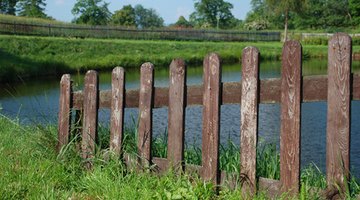What Is Dog Eared Fencing?
Table of Contents
Fencing is one of the most common methods of adding flair and privacy to a yard and property. Out of the several available styles of fence boards, dog-eared fencing designs remain a popular and often economical choice.

Dog-ear boards can be used in several styles of fencing, from privacy to shorter, picket-style spaced fencing.
Function
A dog-ear board or panel of boards is used in the same way as many other fences. The panels are placed around the yard or a certain area to decorate or provide privacy. The term "dog-ear" only applies to the shape of the board--they are used in lengths ranging from two to eight feet, and occasionally higher fences.
Name
The term "dog-ear" applies to the shape of the top of the boards. Instead of a flat top, the boards have the corners sawed off, providing a "dog-ear" shape, or half-hexagonal shape, to the top of the boards. The shape is similar to a semi-prick or drop ear shape on certain dogs.
Materials
Dog-ear boards are primarily made out of wood. Cedars, treated lumbers and whitewoods are all commonly used to manufacture these fences, like other wood-fence styles. Composites, which are made of both wood and plastic together, are also being used more frequently to manufacture dog-ear and other styles. Composite doesn't require the upkeep that wood does, although it has the appearance of wood.
Types
Whether a fence is wanted for privacy or decoration, dog-ear boards fit the task. Dog-ear boards can be spaced out on a panel similar to picket-fencing, put next to each other on a panel for privacy, or used in a shadow-box method, which is when the boards are positioned on each side of the panel in a slightly overlapping pattern. Shadow-box fences allow wind to pass through more easily--as opposed to traditional privacy panels--and still add privacy to the yard because of their overlapping design.
Cost Factors
Because dog-ear boards are not overly ornate in design, they are considerably less expensive than boards with a more ornate design. The material used will greatly influence the price of the fencing, as different woods cost more or less than others. The value of different materials is also greatly influenced by maintenance costs.
References
Writer Bio
With a professional background in gardening, landscapes, pests and natural ecosystems, Jasey Kelly has been sharing her knowledge through writing since 2009 and has served as an expert writer in these fields. Kelly's background also includes childcare, and animal rescue and care.
Photo Credits
- fence image by martini from Fotolia.com
- fence image by martini from Fotolia.com
More Articles



